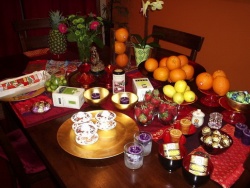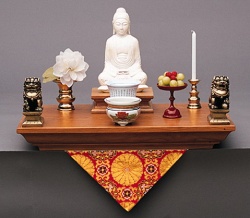Setting Up the Altar and Protecting the Gohonzon
A first step in the practice of Nichiren Buddhism is receiving the Gohonzon and enshrining it in your home. Out of consideration for other members of the household, it is best to take some time to explain to them about your Buddhist practice and thereby gain their support.
Your sponsor and SGI-USA district leaders will help you choose an optimal place in your home to set up an altar, usually made of wood or plastic, in which the Gohonzon will be housed, and plan a time for the enshrinement. These altars come in many designs and sizes, and can be purchased at local SGI-USA bookstores, on-line or in stores that specialize in making altars.
They will help with placing the Gohonzon in the altar, carefully making sure that it hangs straight. The Gohonzon may curl forward at the bottom when first unrolled, but it is best not to roll it backward in an attempt to straighten it. In a matter of days, it should straighten as gravity pulls on the lower rod.
Daily practice is a vital part of Buddhism. The altar and surrounding area should be kept clean and, out of respect, we avoid breathing directly on the scroll. We take care when dusting the interior of the altar, and especially avoid touching the face, or white portion, of the Gohonzon.
Traditionally, offerings are made, including evergreens, candles and incensea bell to ring while chanting and reciting the sutra. We might have an offering dish on which some fresh fruit or other food can be placed. Fresh water is placed in a small cup before the Gohonzon prior to each morning's sutra recitation, and is removed before the evening recitation. The water may be put into another cup and then consumed.
When offering food, it is customary to ring the bell three times, place our palms together and chant Nam-myoho-renge-kyo three times as a gesture of deep gratitude. The offering should be removed while still edible.
These traditional offerings serve to honor the Gohonzon (i.e., our own innate potential for enlightenment) and dignify the place where it is enshrined. It is important to note that the appreciation and sincerity we show the Gohonzon is synonymous with showing respect for those qualities within our own lives and, accordingly, will be reflected in our lives as benefit.
Nichiren Daishonin writes, "Whether you chant the Buddha's name, recite the sutra, or merely offer flowers and incensel your virtuous acts will implant benefits and roots of goodness in your life.With this conviction you should strive in faith" ("On Attaining Buddhahood in This Lifetime," The Writings of Nichiren Daishonin, vol. 1, p. 4)

